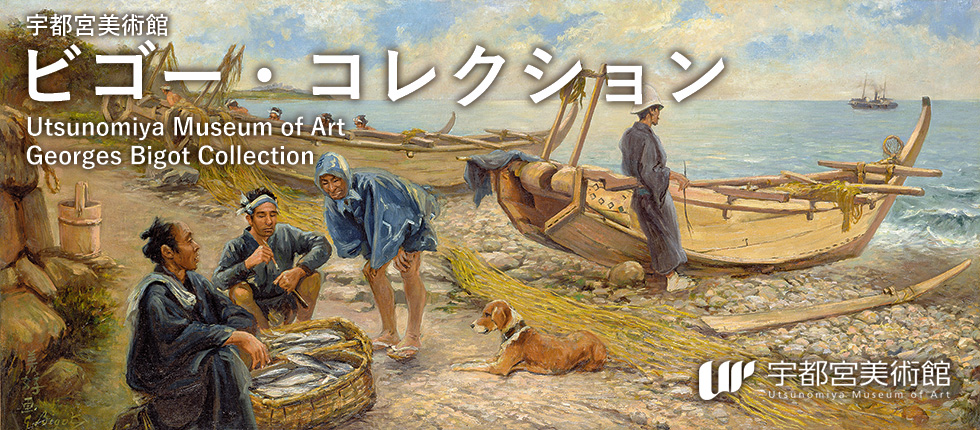詩画集『横浜バラッド』
| コレクション番号 | 19XBC0002 |
|---|---|
| 分類 | 版画本 |
| 作者 | ビゴー,ジョルジュ 1860 西暦1860 1927 昭和2 フランス |
| 作品名(英名) | Poetry and Painting Album, "Yokohama Ballads" |
| 技法素材 | リトグラフ、活版, 紙 |
| 制作年(西) | 1892 |
| 制作年(和) | 明治25 |
| 解説 | [ 第一歌「教育過剰」図 ]、[第二歌「ある会社のバラッド」第一図 ]、 [ 第二歌「ある会社のバラッド」第二図 ]、 [ 第二歌「ある会社のバラッド」第三図 ]、 [ 第二歌「ある会社のバラッド」第四図 ]、 [ 第二歌「ある会社のバラッド」第五図 ]、 [ 第三歌「会社というやつは」図 ]、 [ 第四歌「関税のあれこれ」第一図 ]、 [ 第四歌「関税のあれこれ」第二図 ]、 [ 第四歌「関税のあれこれ」第三図 ]、 [ 第四歌「関税のあれこれ」第四図 ]、 [ 第五歌「日本ノイローゼ」第一図 ]、 [ 第五歌「日本ノイローゼ」第二図 ]、 [ 第六歌「レモン・ゼラニウムの香り」第一図 ]、 [ 第六歌「レモン・ゼラニウムの香り」第二図 ] 本作は日本に滞在する外国人たちの苦悩を描いた詩画集である。表紙および中扉には「G. ビゴー挿絵」とのみ記され、詩文の著者が明記されていない。詩文からフランス語風の訛りが感じられること、およびその内容などからビゴー自身が著したものとみなし、それを前提に議論を展開する先行研究も存在する。ただし、本作の出版直後のものと思われる横浜の英字新聞『ザ・ジャパン・ウィークリー・メイル』紙上の書評記事では、名前を挙げてはいないもののふたりの別々の作者を想定しており(The Japan Weekly Mail, November 5th,1892, p.549. )、議論の余地があろう。 本作は、日本において欧米列強諸国との不平等条約改正を求める機運が高まる中で、外国人に向けられた排外的ないし差別的な視線を批判する作品として語られることが多い。確かにその通りであろうが、他にも軽率な経営者への批判や近代化されていない日本の風習への皮肉も見て取れる。第5歌「日本ノイローゼ」に見られる仕掛け絵本風の試みも興味深く、見どころの多い作品である。 This poetry and picture collection depicts the problems faced by foreigners in Japan. The cover sheet and inner flap state "ILLUSTRATED BY G. BIGOT" but the author of the poetry is unknown. There is a French language style accent to the poetry and some earlier studies have developed the argument that Bigot himself was the author. However, the critique in the Japan Weekly Mail, an English language newspaper published in Yokohama, thought to date from around the time of the publication of this work, surmised that two different authors were involved with the works without listed names (Japan Weekly Mail, November5, 1892, p. 549.). Room for debate remains in this regard. There are many aspects of this work which can be discussed as a work that criticizes the exclusionary or discriminatory gaze directed at foreigners amidst the growing movement seeking rectification to the unequal treaties between Japan and the Western powers of the day. While yes, that is the case, it also can be seen as criticizing careless businesses and satirization of the non-modernized Japanese customs.The 5th poem, "The JÁPAN ’EAD," has a fascinating experiment at a pop-up illustrated book style element, and there are many other interesting elements. |
| 寸法(cm) | 35.3×26.0 |
・本サイトは、宇都宮美術館が所蔵するジョルジュ・ビゴー全作品のデータベースで、作家・作品研究の発展に寄与することを目的に公開しています。
・本サイトに掲載された全てのテキストの著作権は宇都宮美術館に帰属します。
・本データベースで得た情報は利用者の責任のもと自由に活用していただくことができます。ただし、その利用がもとで何らかのトラブルが発生した場合には、
宇都宮美術館は一切の責任を負いかねます。
・公開情報は、ビゴー作品の調査研究に応じて、随時更新を行っています。
【高精細画像の貸出について】
本データベースに掲載されているものより高精細の画像を利用されたい方は、別途下記までお問い合わせください。
(有料。利用目的に応じ価格が異なります。データ送付での供給となります。)
〒320-0004栃木県宇都宮市長岡町1077 宇都宮美術館 写真原版利用係 電話028-643-0100
メールアドレス um0a-1nf0rm@u-moa.jp
・本サイトに掲載された全てのテキストの著作権は宇都宮美術館に帰属します。
・本データベースで得た情報は利用者の責任のもと自由に活用していただくことができます。ただし、その利用がもとで何らかのトラブルが発生した場合には、
宇都宮美術館は一切の責任を負いかねます。
・公開情報は、ビゴー作品の調査研究に応じて、随時更新を行っています。
【高精細画像の貸出について】
本データベースに掲載されているものより高精細の画像を利用されたい方は、別途下記までお問い合わせください。
(有料。利用目的に応じ価格が異なります。データ送付での供給となります。)
〒320-0004栃木県宇都宮市長岡町1077 宇都宮美術館 写真原版利用係 電話028-643-0100
メールアドレス um0a-1nf0rm@u-moa.jp


